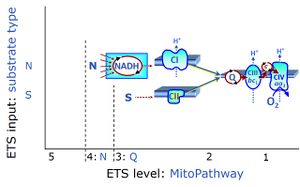Difference between revisions of "NS-pathway control state"
m (moved NS-substrate state to NS-pathway control) |
|||
| Line 2: | Line 2: | ||
|abbr=NS, CI<small>&</small>II | |abbr=NS, CI<small>&</small>II | ||
|description=[[File:SUIT-catg NS.jpg|right|300px|NS-substrate state]] | |description=[[File:SUIT-catg NS.jpg|right|300px|NS-substrate state]] | ||
'''NS-pathway control''' is exerted in the NS-linked substrate state (flux in the NS-linked substrate state, NS; or Complex I<small>&</small>II, CI<small>&</small>II-linked substrate state). NS is induced in mt-preparations by addition of [[NADH]]-generating substrates ([[N-linked substrate state]], or CI-linked pathway control) in combination with [[succinate]] ([[S-pathway control]]; S- or CII-linked). Whereas NS expresses substrate control in terms of substrate types (N and S), CI<small>&</small>II defines the same concept in terms of the convergent pathway to the [[Q-junction]] (pathway control). '''NS''' is the abbreviation for the combination of N- or [[NADH]]-linked substrates (CI-linked) and S- or [[succinate]]-linked substrates (CII-linked). This physiological substrate combination is required for partial reconstitution of [[TCA cycle]] function and convergent electron-input into the [[Q-junction]], to compensate for metabolite depletion into the incubation medium. NS in combination exerts an [[additive effect of convergent electron flow]] in most types of mitochondria. | |||
|info=[[Gnaiger 2014 MitoPathways]], [[Gnaiger_2009_Int J Biochem Cell Biol]] | |info=[[Gnaiger 2014 MitoPathways]], [[Gnaiger_2009_Int J Biochem Cell Biol]] | ||
}} | }} | ||
Revision as of 16:05, 26 August 2016
Description
NS-pathway control is exerted in the NS-linked substrate state (flux in the NS-linked substrate state, NS; or Complex I&II, CI&II-linked substrate state). NS is induced in mt-preparations by addition of NADH-generating substrates (N-linked substrate state, or CI-linked pathway control) in combination with succinate (S-pathway control; S- or CII-linked). Whereas NS expresses substrate control in terms of substrate types (N and S), CI&II defines the same concept in terms of the convergent pathway to the Q-junction (pathway control). NS is the abbreviation for the combination of N- or NADH-linked substrates (CI-linked) and S- or succinate-linked substrates (CII-linked). This physiological substrate combination is required for partial reconstitution of TCA cycle function and convergent electron-input into the Q-junction, to compensate for metabolite depletion into the incubation medium. NS in combination exerts an additive effect of convergent electron flow in most types of mitochondria.
Abbreviation: NS, CI&II
Reference: Gnaiger 2014 MitoPathways, Gnaiger_2009_Int J Biochem Cell Biol
MitoPedia concepts:
Respiratory state,
SUIT state
MitoPedia topics:
Substrate and metabolite

